
Posts Tagged: rodent
Ground Squirrels Thrive Year-Round in Avocado Orchards
Ground squirrels eat a variety of fresh greens as well as seeds and dried nuts. In spring, ground squirrels prefer greens over seeds and nuts. Once the natural grasses begin to dry and wither, squirrels will actively forage for seeds.
As foragers, squirrels are well-adapted to find sparsely dispersed food, one seed at a time. Once squirrels have had their fill, they will
collect food in their cheek pouches and take it back to the nest to form a cache for later use. Squirrels tend to forage close to their burrow, although they will travel for desirable foods.
How Biology relates to control:
The California ground squirrel prefers to forage for food in the early morning or late afternoon/early evening to avoid the day's heat. In some crop situations, especially nut crops, squirrels may prefer the crop to the point where they will not eat any bait. If the squirrel won't eat the bait, the poison bait method will not work. In this case, an alternative control approach may be necessary (trapping or fumigation).
Understanding these feeding preferences is extremely important when using baits since they are seed based. Also, in irrigated crops or landscape areas, squirrel feeding preferences are influenced by what food is available. For example, the natural vegetation may be dry in early summer and squirrels are actively foraging for seed. If newly sprouted crops are available however, the squirrels may take them with great delight.
The calendar of ground squirrel diet, activity and control measures is adapted from the Best Management Practices for Ground Squirrel Control website http://ipm.ucanr.edu/PMG/PESTNOTES/pn7438.html. Calendar dates are merely an estimation of time; actual time frames may vary according to the weather and location.
Ground squirrels - Spenrophilus sp. of which there are 17 species may cause damage to avocado orchards by eating fruit, branches, and making burrows near or under trees which expose roots and redirect irrigation water. The most common ground squirrel is the California or Beechey ground squirrel Spermophilus beecheyi.
*An adult will weigh from 1 to 2 ½ pounds and is tan in color with flecked or mottled fur.
*Females produce one litter each year, averaging six to eight offspring.
*They are active in the daytime.
*Their diet may consist of green herbage in winter and spring and seeds during the summer and fall.
*They hibernate during cold winters, but are active year-round in avocado growing areas
*Ground squirrels are not repelled by any chemical or physical means. Thus, control through the use of toxic fumigants, poison baits, traps, or shooting is the only effective control measures available
*They are also preyed on by eagles, raccoons, foxes, badgers, weasels, rattlesnakes and clever dogs
more on those cute animals:
http://ipm.ucanr.edu/PMG/PESTNOTES/pn7438.html

ground squirrel
Rats in Your Orchard
The roof rat (Rattus rattus), sometimes called the black rat, is a common vertebrate pest in citrus, avocado and other yummy tree orchards. It builds leaf and twig nests in fruit trees or nearby trees, or it can nest in debris piles or thick mulch on the ground. This agile, sleek rat has a pointed muzzle, and a tail that is longer than the body and head combined.
Be sure to identify the species of rat present to avoid killing nontarget or protected species. Be aware that endangered native kangaroo rats (Dipodomys spp.) and the riparian woodrat (Neotoma fuscipes riparia) resemble pest rats, but are protected by law. Unlike the hairless, scale-covered tail of roof rats, the tails of kangaroo rats and the riparian woodrat are covered with fur. The riparian woodrat is active mostly during the day, and its tail is somewhat shorter than the combined length of its body and head. A kangaroo rat's tail is noticeably longer than its body and head combined. Kangaroo rats are nocturnal, but unlike Norway rats and roof rats, which move on all four legs, kangaroo rats hold their front legs off the ground and travel by hopping on their hind legs.
Rats gnaw on electrical wires, wooden structures, and fruit on trees. After harvest, they damage fruit in bins, chewing on the bins and leaving excrement. Rats are active throughout the year, and mostly at night.
To help manage rats, reduce shelter and nesting sites of rats. Eliminate debris and wood piles. Store materials neatly and off the ground. Thin and separate non-crop vegetation around orchards where feasible. Exclude rats from nearby structures by properly sealing entry ways.
Baits and rat-sized snap traps placed in trees are the most effective control measures. Rats are wary, tending to avoid baits and traps for at least a few days after their initial placement. Fasten traps to limbs and bait them with sweet fruit or nut meats, but do not set the traps until after bait is readily eaten. Secure anticoagulant wax blocks in a bait station before placing in trees on limbs 6 feet or more above the ground. Placing the wax blocks in a bait station will prevent chunks of the anticoagulant wax from dropping to the ground and creating a hazard.
Be aware that certain types of single-dose rat baits for use inside buildings are not labeled for use outdoors in orchards; these are hazardous to wildlife and should not be used.
For more on the subject see:
http://icwdm.org/handbook/allPDF/RO_B125.PDF
http://www.ipm.ucdavis.edu/PMG/PESTNOTES/pn74106.html
and another blog:
//ucanr.edu/blogs/blogcore/postdetail.cfm?postnum=16880
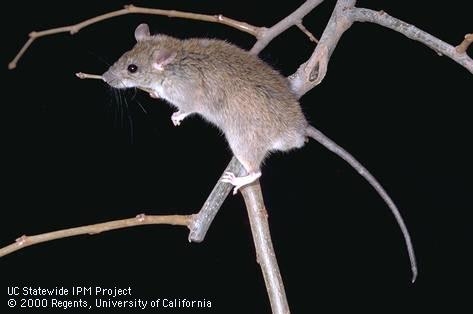
roof rat
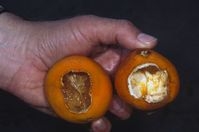
rat damage to citrus
Vole Damage in Citrus Revisited
Since the first publication of this article on vole damage in citrus, a recent field observation regarding vole activity is worth noting. Voles prefer a situation where there is cover and shelter generally from weed or grass. In some orchards established in the last few years a plastic strip has been installed along the tree row for weed management (Fig 1). These strips appear to be offering a sheltered environment for vole activity in some cases (Fig 2). Recent observations in two such installations, one a block planted in 2013 and the other an eight year old planting exhibited significant vole activity. The young orchard at this point does not exhibit obvious tree damage although active tunneling is apparent (Fig 3). In the older orchard feeding damage to the trunks is very obvious (Fig 4).
Meadow Mice (Voles) can cause serious damage in a citrus orchard resulting in partial or complete girdling of a tree (Fig 5). Trees often exhibit damage to the bark of the tree from the soil line up 6-8 inches (Fig. 6 ). On close inspection, an open hole 1-1.5 inches in diameter may be found at the base of the tree (Fig 7).
Five species belonging to the genus Microtus are found in California, two of which “Microtus californicus” and “M.montanus” are reported to cause damage. Damage has been reported in permanent pasture, alfalfa, hay, artichokes, Brussels sprouts, carrots, cauliflower, potatoes, sugar beets, tomatoes, grains, nursery stock and the bark of apple, avocado, citrus, cherry and olive trees.
Microtus are often found where there is grass cover. They generally do not invade cultivated crops until the crop is tall enough to provide food and shelter. Meadow mice are active all year round. They forage at any time during the day or night but are chiefly nocturnal. They are usually found in colonies marked by numerous 2-- inch wide surface runways though matted grass. Small brownish fecal pellets and short pieces of grass stems along the runways are evidence of activity. The burrows consist of extensive underground tunnels, nest chambers and storage chambers. Home range is typically small, less than a 60 foot radius in the case of “M.californicus”. All meadow mice swim well. Therefore, irrigation ditches will not serve as effective barriers against meadow mice movement into fields. Meadow mice may forage beyond the sheltered runways. Food consists of tubers, roots, seeds, grain, and succulent stems and leaves.
Females breed at 4 to 6 weeks of age with litter size of “M.californicus” averaging around 4. Under natural conditions a female Microtus may produce from 5 to 10 litters a year. The major breeding season corresponds with the season of forage growth. Microtus populations build up to a peak every 3 to 4 years, followed by a rapid decline during the next breeding season. The exact causes of the cycle of buildup and decline are not known, though disease, food shortages, physiological stress from overcrowding, and other factors may be involved. It is assumed that in cultivated areas Microtus populations are permanently based in favorable habitat such as roadsides, canal banks or adjacent noncultivated land. Invasion of cultivated cropland occurs when the population builds up or when the wild habitat becomes unfavorable. Coyotes, badgers, weasels, snakes, hawks, owls, herons and gulls are among the principal predators. It is believed that predators are not able to prevent or control a population eruption because of the birth rate of the fast breeding Microtus population. Meadow mice are classified as nongame mammals by the California Fish and Game Code. Nongame mammals, which are found to be injuring growing crops may be taken at any time or in any manner by the owner/management. The most effective management options in an orchard situation are a reduction in ground cover and the use of toxic baits. Meadow mice are cover dependent. In situations where cover removal is not possible or is insufficient to solve the problem, the next best option is the use of toxic baits. Many bait carriers are used (e.g., oat groats, wheat bait). Baits: Crimped oat groats are the most satisfactory bait although crimped whole oats are used (e.g., oat groats, wheat grains, pelletized formulations, etc., but crimped oat groats have typically been most effective). The primary toxicants used for meadow mouse control include zinc phosphide, diphacinone, and chlorophacinone. Directions for management including baiting can be obtained by contacting the Agricultural Commissioner's Office. * Portions taken from J.P.Clark Vertebrate Pest Control
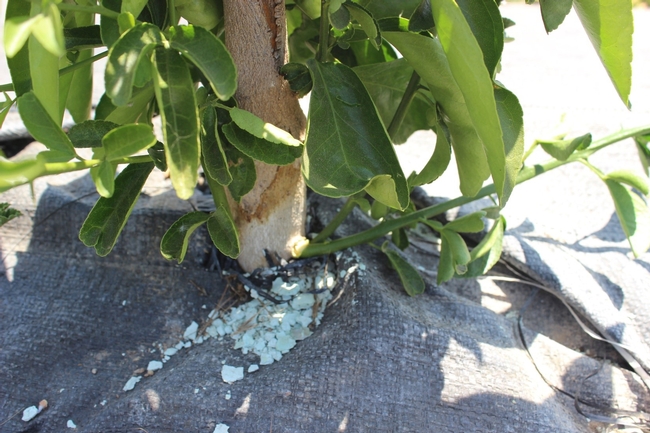
vole 1

vole 2

vole 3

vole 4
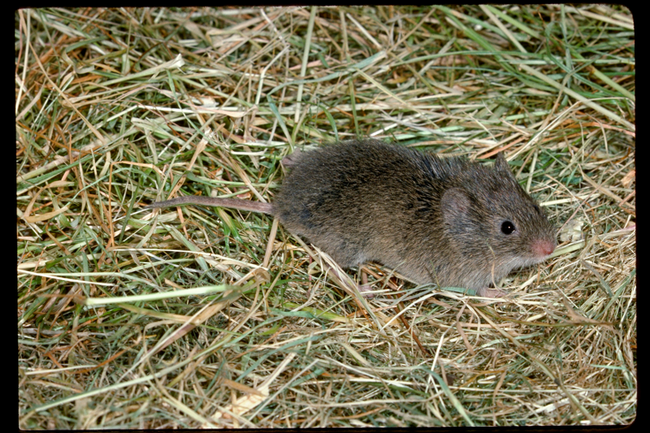
vole 5
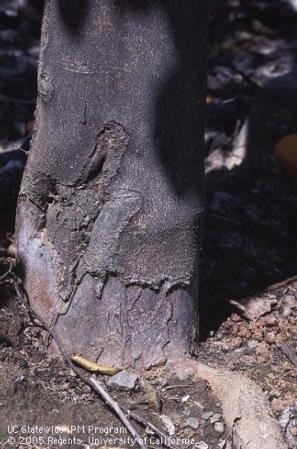
vole 6

vole 7
